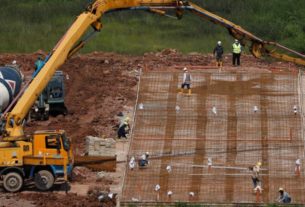With attention focused largely on holiday celebrations in the past couple of weeks, most Thais probably missed the news about a milestone event in Nicaragua just before Christmas. The event was a groundbreaking ceremony, commencing the construction of the Nicaragua Canal linking the Pacific Ocean with the Atlantic Ocean.
Projected to be completed in five years, this 278km canal, costing some US$50 billion (1.7 trillion baht) and financed by a Hong Kong company, will complement as well as compete with the Panama Canal, which celebrated its centennial last year.
According to its proponents, the new canal, passing through the southern half of Nicaragua, and associated investments in ports, industry, tourism and other services, will lift Nicaragua out of poverty. With a population of six million and GDP of some $12 billion, Nicaragua no doubt will be transformed by such a gargantuan project, economically or otherwise.
For Thais who were aware of the groundbreaking ceremony, progress on the Nicaragua Canal has probably prompted them to ask questions about Kra Canal again — as to when and if it will ever become a reality.
The idea of linking the Indian Ocean with the Pacific Ocean via a canal across the Kra Isthmus in Southern Thailand is as old as those that led to the construction of the Suez, the Panama and the Nicaragua canals, but for various reasons, it has remained on the shelf. With world commerce continuing to rise and so much capital available — from private as well as government sources, including China and the Asian Infrastructure Investment Bank — now is as good a time as any for the Thai government to proceed with the Kra Canal.
Granted, the Kra Canal will not be as transformational as the Nicaragua Canal, for Thailand is much bigger than Nicaragua in terms of economic, geographic and population sizes. But it will be a major engine for many substantive — and largely positive — changes, especially in the southern region of Thailand. No less important, the decision to proceed with such a large project may also change the psyche of many Thais, who have been highly reluctant when it comes to making decisions of great economic magnitude. If the present Thai leadership is looking for something to leave behind as its legacy, the Kra Canal will last much longer than things it is working on, including the new constitution.
Should the Kra Canal project get the go-ahead in the near future, it would be easier for our leaders — now and in the future — to consider other big ideas being discussed in private quarters. One is about construction of another major canal, dubbed Chao Phraya 2. This 200 metre-wide canal will lie east of the Chao Phraya River, beginning in Nakhon Sawan and ending in the Gulf of Thailand near the mouth of the Bang Pakong River. Chao Phraya 2 will come with other associated investments, such as a major port, transport networks, lakes and modern towns that will serve as centres of government offices and the digital industry that the present government is trying to promote. The canal and lakes will eliminate the threat of flooding in the Central Plains, similar to that experienced in 2011.
Another idea is to pockmark most of Thailand’s agricultural areas with ponds 2-4 metres deep, covering some 2,000 square metres. Every hectare of agricultural areas not served by irrigation projects would have one such a pond, beginning in the Northeast which often faces the most severe water shortages during the dry season.
The idea of combating water shortages by digging ponds or constructing water tanks, to harvest rain water for use during droughts is centuries old. It has been proven effective in many parts of the world, even in the highly arid regions of India. But few Thai farmers have used the technique. Most are reluctant to devote their land to such ponds because they do not wish to lose the rice-growing areas of their already small farms. To overcome such reluctance, the government needs to make construction of ponds a national project by taking over — with some compensation to the owners — the specific spaces on which the ponds will be dug. This could be done in stages, beginning perhaps in the northeastern province of Yasothon. Once completed, the ponds would be maintained by farmers or communities using the water.
Bringing up these ideas will no doubt raise many questions and some outright objections, many concerning their costs and potential impact on the environment. But if the present leadership is open-minded, imaginative and serious enough in its intent to reform the country, plus successful enough in reducing corruption, most of the questions should be satisfactorily answered.
If Chao Phraya 2 seems far-fetched, there is nothing wrong with at least launching a feasibility study. The countrywide rain-harvesting project could be done in stages, each costing a few million baht perhaps. It could be adjusted if necessary, so the first stage should start right away. Many studies on the Kra Canal have already been undertaken. If the government decides to proceed, further preparation work and financial arrangements should not take long. Only one major question remains: Is the present leadership gutsy enough to give it the go-ahead?
Source: http://www.bangkokpost.com/opinion/opinion/454940/big-ideas-like-kra-canal-take-guts-to-follow-through-on


